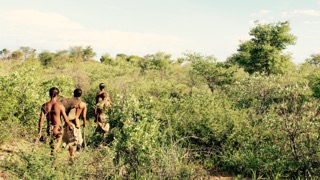
08 Jul Permaculture in the Namibian Bush
Back in 2014 I traveled to Namibia with the idea of visiting various San communities along the way, nomadic hunter gatherer people who have lived in the area for 200 centuries. My aim was to find the San who still live close to their original Hunter gatherers ways as I wanted to learn tracking and foraging skills from them. I was aware that these skills were being lost fast as they were modernizing. Almost at the end of that journey, i found the ‘Little hunters’ in their village of Xa/Xoba and knew that I found what I was looking for. The village consisted of about 30 adults and as many children. They were still allowed to hunt and forage like their ancestors had done. In all the other parts of Namibia and Botswana that I visited, this was not the case anymore. Soon I was tracking with them and occasionally going out hunting with the men. On certain days I would accompany the woman as they went foraging, and I got to know and love the people in that village. I also started realizing how fast change was happening for them. Many young San now had a mobile phone though there was hardly any signal. They could no longer move around as they used to, now settled in villages their wild food resources around them started to become very depleted. People were starting to become dependent on monthly government handouts of Maize and some tinned foods. Although the San were still supplementing it with wild food it was very apparent that it was not going to hack it in the long run.
I returned in 2016 and had a meeting with he whole village to see what could be done. It became clear that they were far happier eating the wild food that they were used to, so I proposed we grow a forest garden in and around their settlements thus cultivating and bringing the wild food closer to their homes. The elders agreed that this was a good plan and that although it will not produce food straight away it would start providing food for the village in about 5 years and become a greater source as time went by. Most trees we could transplant from the wild and some could be purchased from a nursery not too far away. The biggest challenge that we faced was the mid year drought, and to give the young trees the best chance of making it through we decided to install an irrigation system that could be moved and re-used on new trees after 2 years. Another challenge was to get the pipes and trees to the village as the closet town to purchase was 300 km away and the road was only accessible by 4×4. A vehicle was needed. I vowed to return the next year with all we needed, so it was with this intention that I approached The Wandering Samaritan to ask for financial assistance.

Great excitement greeted me as I arrived back in the village in Feb 2017 with a vehicle laden with trees and pipes. We started the work straight away and managed to lay the pipes and plant about 80 trees from 10 different species in 5 days. 40 were planted in a fenced off area and another 40 around people’s homes. These trees will create the highest or top story of the food forest. In the next phase some lower trees will be planted as well as some bushes, creepers, herbs and ground cover crops to complete a well functioning closed system. The irrigation system is very simple to operate and requires one person to open a tap at dusk and close it again at dawn. Once the trees are established it can be moved and the food forest can be expanded.
The best moment for me was to see the young teenagers really get engaged after a few days when they really got the concept of what we were doing. I felt that they realized that we were doing this for them and their future survival, not only on a physical plain but also culturally. They will be able to keep on eating the food that they always had and the only labour needed, when well established in about 10 years, will be the harvesting. For a young person growing up in a very uncertain time it brought much needed encouragement. I was also approached by a teacher from the local school asking if it might be possible to grow another food forest at the school which set me thinking…Mmmmm
As a permaculture consultant I wander around Africa helping on existing projects and initiating new ones. I have learned that one cannot just tell people what to do, you have to show them. That’s how people learn to help each other . I feel that I have left a community more empowered and more confident, that they can feed themselves, and that there is a future for their children devoid from any outside aid. That poverty is just a frame of mind. What they have is what many of us long for in the west. They have land, a community, and an intact culture. Everything gets shared equally amongst everyone. They have taught me so much and I am very grateful that I can give something in return.
There are more phases to apply and I will return to help with those but eventually I want to be able to step away and know that there are local folk on the ground who can help others achieve the same. This, after all, is what permaculture is all about .
When the JoHuansi see each other they say: ’we walk together.’ So thank you to The Wandering Samaritan for walking together with us for a moment in time on this journey.
Casparo
Updated: Check out the wrap up video of the whole incredible experience here.

















No Comments